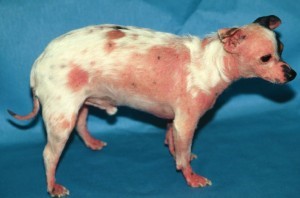
There are a few species of Demodex mites that can cause canine demodicosis. The most common is Demodex canis. Demodex canis is a normal inhabitant of the skin of healthy dogs and resides in hair follicles. The mite spends its entire life cycle on the dog, and it is not considered to be contagious. Dogs become colonized with this mite shortly after birth by direct transmission from the mother to the puppy. Under normal conditions, the presence of low numbers of mites does not cause lesions or disease. However, certain genetic factors and/or impaired immune system function may result in proliferation of mite numbers in hair follicles, causing skin lesions and hair loss. Clinical signs and lesions associated with a proliferation of mites are variable but can include hair loss (alopecia), red skin (erythema), papules (red bumps), pustules (pimples), hemorrhagic bullae (purple-red blisters), comedones (black heads), crust, scale, or even nodules. Itch is not typically a feature of canine demodicosis unless there is also secondary bacterial infection affecting the skin.
Demodex injai is another type of Demodex mite and is a normal inhabitant of the sebaceous (oil) glands in the skin, in addition to hair follicles. Proliferation of these mites can cause greasy skin, redness, and scaliness, most commonly on the face and/or back. Terrier breeds are most commonly affected by over proliferation of these mites.
Canine Demodex Diagnoses
Your veterinarian will do skin scrapings or hair pluckings when there are lesions that could indicate demodicosis. They will evaluate the collected material for mites using a microscope. If present, mites are generally easy to recover with this in-hospital diagnostic test. Rarely, biopsies are needed to detect the presence of Demodex mites.
We characterize canine demodicosis based upon age of the dog and extent of lesions. Characterization dictates how we treat and monitor patients.
- Juvenile-onset demodicosis is diagnosed when a dog is less than 1 year of age (2 for some breeds) at the onset of clinical signs. Most of these dogs develop lesions between 4 and 12 months. In addition to genetic and immunologic factors, we consider the nutritional status, presence of other parasites, stress, heat cycles, and the possibility of other underlying diseases that can result in mite proliferation.
- Adult-onset demodicosis is diagnosed when the first clinical signs of the disease occur after the age of 1-2 years. For these dogs, we recommend diagnostic tests to look for underlying conditions resulting in immunosuppression such as hyperadrenocorticism (excessive cortisol production by the body), hypothyroidism, other systemic diseases, or cancer. Dogs receiving chemotherapy or other immunosuppressive treatments can also be affected.
- Localized demodicosis is diagnosed when there are few lesions limited to a few body sites.
- Generalized demodicosis is diagnosed when there is widespread disease involving several body sites, any number of paws, or a whole body region.

Canine Demodex Treatment
Localized juvenile-onset demodicosis is monitored without additional treatment, as it may resolve with time. All other forms of demodicosis are usually treated. Additional recommendations include spaying and or neutering the pet, deworming if indicated, ensuring a good plane of nutrition, and treating secondary infections. Several products are effective for treatment of demodicosis in dogs. Most recently, flea and tick preventatives in the isoxazoline class of drugs (including Nexgard®, Bravecto®, Credelio™, and Simparica ®) have successfully been utilized off-label for the treatment of demodicosis in dogs. These medications have revolutionized treatment of Demodex by providing a much easier and safer treatment option than were available in the past. A veterinarian should be consulted about the most appropriate treatment plan for each individual pet.
The aim of treatment is remission. Remission is achieved when there are two consecutive appointments at which deep skin scrapings looking for the presence of mites are completely negative. Treatment is then continued for four additional weeks and then can be discontinued. If there is no recurrence after one year, the dog is considered cured. Relapses do occur and are usually recognized in the first three to six months after treatment is discontinued; in these cases, treatment is restarted and typically must be continued long-term. Nowadays, isoxazoline medications are often continued indefinitely in dogs diagnosed with demodicosis in order to prevent relapse since these products are labeled for prolonged use for flea and tick prevention.
Do you think your dog is suffering from mites? Find a MedVet dermatologist near you!

